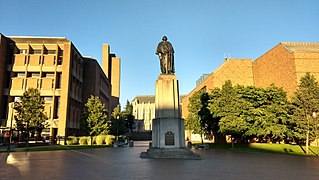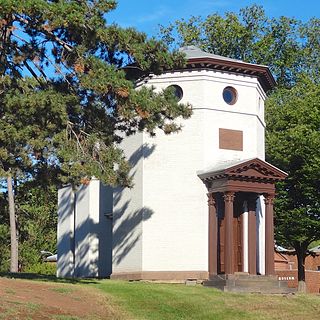
The Washburn Observatory is an astronomical observatory located at 1401 Observatory Drive on the University of Wisconsin–Madison campus in Madison, Wisconsin, United States. Completed in 1881, it was a major research facility for about 50 years. Today, it is home to the UW-Madison College of Letters and Science Honors Program, while the telescope remains in use by students in introductory astronomy courses and the general public during open houses and viewings.

The Apache Point Observatory is an astronomical observatory located in the Sacramento Mountains in Sunspot, New Mexico, United States, approximately 18 miles (29 km) south of Cloudcroft. The observatory is operated by New Mexico State University (NMSU) and owned by the Astrophysical Research Consortium (ARC). Access to the telescopes and buildings is private and restricted.

The David Dunlap Observatory (DDO) is an astronomical observatory site in Richmond Hill, Ontario, Canada. Established in 1935, it was owned and operated by the University of Toronto until 2008. It was then acquired by the city of Richmond Hill, which provides a combination of heritage preservation, unique recreation opportunities and a celebration of the astronomical history of the site. Its primary instrument is a 74-inch (1.88 m) reflector telescope, at one time the second-largest telescope in the world, and still the largest in Canada. Several other telescopes are also located at the site, which formerly also included a small radio telescope. The scientific legacy of the David Dunlap Observatory continues in the Dunlap Institute for Astronomy & Astrophysics, a research institute at the University of Toronto established in 2008.

Perkins Observatory is an astronomical observatory in Delaware, Ohio. It is owned and operated by Ohio Wesleyan University.

The Institute of Astronomy (IoA) is the largest of the three astronomy departments in the University of Cambridge, and one of the largest astronomy sites in the United Kingdom. Around 180 academics, postdocs, visitors and assistant staff work at the department.

Goldendale Observatory State Park is an educational facility on the northern side of Goldendale, Washington, notable for its unusually large public telescope. The state park occupies five acres (2.0 ha) atop a 2,100-foot (640 m) hill.

The Vassar College Observatory is an astronomical observatory of the private Vassar College, located near the eastern edge of the Poughkeepsie, New York college's campus. Finished in 1865, it was the first building on the college's campus, older even than the Main Building, with which it shares the status of National Historic Landmark. The observatory's significance is due to its association with Maria Mitchell, the first widely known female astronomer in the United States.

Mount Laguna Observatory (MLO) is an astronomical observatory owned and operated by San Diego State University (SDSU). The telescope was operated in partnership with the University of Illinois at Urbana-Champaign (UIUC) until 2000. MLO is located approximately 75 kilometers (47 mi) east of downtown San Diego, California (USA) on the eastern edge of the Cleveland National Forest in the Laguna Mountains on the SDSU Astronomy Campus near the hamlet of Mount Laguna. MLO was dedicated on June 19, 1968, seven years after SDSU's Department of Astronomy became an independent academic department of SDSU's College of Sciences. The dedication took place during the 1968 summer meeting of the Astronomical Society of the Pacific. Currently SDSU is working with University of Kansas (KU), and UNC Chapel Hill on various projects. MLO also engages with the public through a series of scientific outreach efforts such as the summer visitors program (SVP). SVP's take place on select dates throughout the summer months and include scientific demonstrations in the museum / gift shop, an introductory lecture on astronomy, and a stargazing session using a myriad of telescopes such as the 0.52 m Reginald Buller 21-inch Visitors' Telescope. The SVP is predominantly run by graduate students within the SDSU Astronomy Master's program.

The Warner and Swasey Observatory is the astronomical observatory of Case Western Reserve University. Named after Worcester R. Warner and Ambrose Swasey, who built it at the beginning of the 20th century, it was initially located on Taylor Road in East Cleveland, Ohio, USA. The observatory, which at that time housed a 9.5-inch (24 cm) refractor, was donated in 1919 to the Case School of Applied Science. The newer 24-inch (61 cm) Burrell Schmidt telescope was built in 1939.

The Manastash Ridge Observatory (MRO) is an astronomical observatory built in 1972 by the University of Washington. It is located in a remote area approximately 14 kilometers (8.7 mi) west of Ellensburg, Washington, at an altitude of 3930', a longitude of 120.7278 degrees West, and a latitude of +46.9528 degrees, and can be reached by dirt roads from Ellensburg or Selah. The observatory features a 0.75 m (30 in) Ritchey-Chrétien telescope built by Boller and Chivens. Currently, the observatory utilizes an Andor thermo-electrically cooled CCD camera in conjunction with the primary telescope. Initially used for professional and graduate research, the observatory is now used mostly by undergraduate students for instruction and research. For a brief time there was talk of stopping funding for MRO as the University of Washington Astronomy Department focus on the Apache Point Observatory, but funding did continue and MRO is still in use.

Shattuck Observatory is an astronomical observatory owned and operated by Dartmouth College in Hanover, New Hampshire, United States.

The University of Illinois Astronomical Observatory, located at 901 S. Mathews Avenue in Urbana, Illinois, on the campus of the University of Illinois Urbana–Champaign, was built in 1896, and was designed by Charles A. Gunn. It was listed on the National Register of Historic Places on November 6, 1986, and on December 20, 1989, was designated a National Historic Landmark.

The Detroit Observatory is located on the corner of Observatory and Ann streets in Ann Arbor, Michigan. It was built in 1854, and was the first scientific research facility at the University of Michigan and one of the oldest observatories of its type in the nation. It was designated a Michigan State Historic Site in 1958 and placed on the National Register of Historic Places in 1973.

Fuertes Observatory is an astronomical observatory located on the North Campus of Cornell University in Ithaca, New York. The observatory was designed by L.P. Burnham, Cornell Professor of Architecture and completed in fall of 1917. It was originally used by the Civil Engineering Department as an instructional field office for navigation and surveying. Today, the observatory is primarily used for public outreach, welcoming over two thousand visitors per year with open houses on clear Friday nights.

The Dearborn Observatory is an astronomical observatory located on the Evanston campus of Northwestern University. The observatory was originally constructed in 1888, through an agreement between the university and the Chicago Astronomical Society. In the summer of 1939, Dearborn Observatory had to be moved to make way for the construction of the Technological Institute.

The Georgetown University Astronomical Observatory was founded in 1841 by Father James Curley of the Department of Physics at Georgetown College. Father Curley chose a site on the college grounds, planned the building, and supervised its construction to its completion in 1844. Costs were initially paid by Rev. Thomas Meredith Jenkins, S.J., and Rev. Charles H. Stonestreet, S.J., who were Georgetown professors at the time. The observatory was used in 1846 to determine the latitude and longitude of Washington, D.C., which Curley determined to be latitude 38°54′26N and longitude 5h8m18.29s.
The Dark Sky Observatory (DSO) is an astronomical observatory owned and operated by Appalachian State University (ASU). It is located 9 kilometers (5.6 mi) east of Deep Gap, North Carolina (USA), off of the Blue Ridge Parkway, and 32 kilometers (20 mi) east of the ASU campus in Boone, North Carolina It was established in 1981, and is used for research, instruction, and public viewing events. The Cline Visitors' Center was completed in 2011.
Tortugas Mountain Observatory (TMO) is an astronomical observatory owned and operated by New Mexico State University (NMSU). It is located on Tortugas Mountain, also known locally as 'A' Mountain, in southern New Mexico (USA), approximately 8 kilometers (5.0 mi) southeast of Las Cruces and 4 kilometers (2.5 mi) east of the NMSU campus. Founded in 1963 under the supervision of Clyde Tombaugh, the observatory focused on observing the planets. Much of the information captured at TMO is now available through the Planetary Data System's Atmospheres Node, which is managed by NMSU. The two-dome observatory building was completed in 1964, though observing began with one of the telescopes in 1963. A second building, with a larger single dome, was completed at the opposite end of the ridgeline of Tortugas Mountain in 1967. Regular use of TMO ceased in 1999 or 2000, but the observatory equipment was not dismantled. In 2008 it was used for the Lunar Crater Observing and Sensing Satellite project. In 2010, efforts to revive the observatory for use by the American Association of Variable Star Observers began. As of 10 June 2011, work on project was reported to be 60-75% done.

The Campus of the University of Washington is located in the University District of Seattle. Campus buildings are categorized by the major street or vicinity on which they are located on campus. In 2011, Slate magazine and Travel+Leisure described the Seattle campus as one of the most beautiful university campuses in the United States.

The Daniel S. Schanck Observatory is an historical astronomical observatory on the Queens Campus of Rutgers University in New Brunswick, New Jersey, United States, and is tied for the seventh oldest observatory in the US alongside the Vassar College Observatory. It is located on George Street near the corner with Hamilton Street, opposite the parking lot adjacent to Kirkpatrick Chapel, and to the northeast of Old Queens and Geology Hall.





















